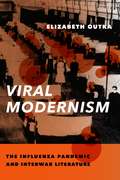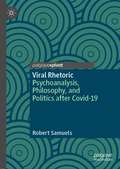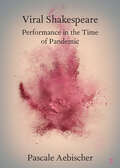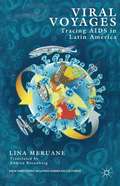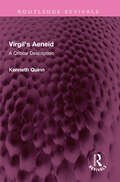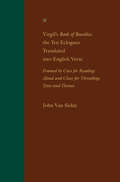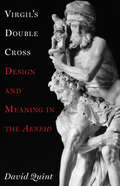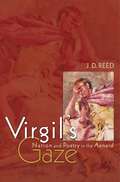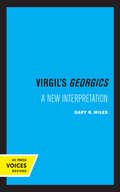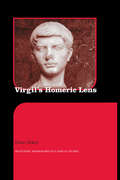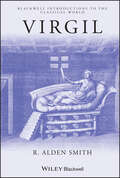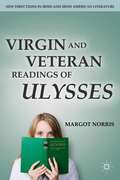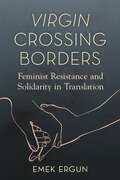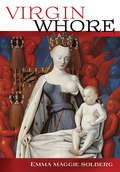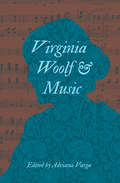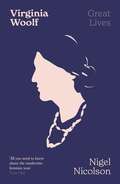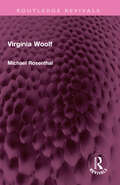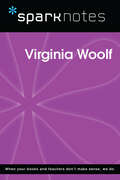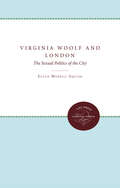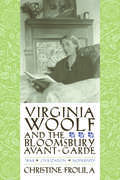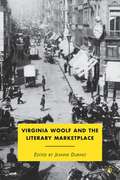- Table View
- List View
Viral Modernism: The Influenza Pandemic and Interwar Literature (Modernist Latitudes)
by Elizabeth OutkaThe influenza pandemic of 1918–1919 took the lives of between 50 and 100 million people worldwide, and the United States suffered more casualties than in all the wars of the twentieth and twenty-first centuries combined. Yet despite these catastrophic death tolls, the pandemic faded from historical and cultural memory in the United States and throughout Europe, overshadowed by World War One and the turmoil of the interwar period. In Viral Modernism, Elizabeth Outka reveals the literary and cultural impact of one of the deadliest plagues in history, bringing to light how it shaped canonical works of fiction and poetry.Outka shows how and why the contours of modernism shift when we account for the pandemic’s hidden but widespread presence. She investigates the miasmic manifestations of the pandemic and its spectral dead in interwar Anglo-American literature, uncovering the traces of an outbreak that brought a nonhuman, invisible horror into every community. Viral Modernism examines how literature and culture represented the virus’s deathly fecundity, as writers wrestled with the scope of mass death in the domestic sphere amid fears of wider social collapse. Outka analyzes overt treatments of the pandemic by authors like Katherine Anne Porter and Thomas Wolfe and its subtle presence in works by Virginia Woolf, T. S. Eliot, and W. B. Yeats. She uncovers links to the disease in popular culture, from early zombie resurrection to the resurgence of spiritualism. Viral Modernism brings the pandemic to the center of the era, revealing a vast tragedy that has hidden in plain sight.
Viral Rhetoric: Psychoanalysis, Philosophy, and Politics after Covid-19
by Robert SamuelsThis book looks at the representation of viruses in rhetoric, politics, and popular culture. In utilizing Jean Baudrillard’s concept of virality, it examines what it means to use viruses as a metaphor. For instance, what is the effect of saying that a video has gone viral? Does this use of biology to explain culture mean that our societies are determined by biological forces? Moreover, does the rhetoric of viral culture display a fundamental insensitivity towards people who are actually suffering from viruses? A key defining aspect of this mode of persuasion is the notion that due to the open nature of our social and cerebral networks, we are prone to being infected by uncontrollable external forces. Drawing from the work of Freud, Lacan, Laclau, Baudrillard, and Zizek, it examines the representation of viruses in politics, psychology, media studies, and medical discourse. The book will help readers understand the potentially destructive nature of how viruses are represented in popular media and politics, how this can contribute to conspiracy theories around COVID-19 and how to combat such misinterpretations.
Viral Shakespeare: Performance in the Time of Pandemic (Elements in Shakespeare Performance)
by Pascale AebischerThis Element offers a first-person phenomenological history of watching productions of Shakespeare during the pandemic year of 2020. The first section of the Element explores how Shakespeare 'went viral' during the first lockdown of 2020 and considers how the archival recordings of Shakespeare productions made freely available by theatres across Europe and North America impacted on modes of spectatorship and viewing practices, with a particular focus on the effect of binge-watching Hamlet in lockdown. The Element's second section documents two made-for-digital productions of Shakespeare by Oxford-based Creation Theatre and Northern Irish Big Telly, two companies who became leaders in digital theatre during the pandemic. It investigates how their productions of The Tempest and Macbeth modelled new platform-specific ways of engaging with audiences and creating communities of viewing at a time when, in the UK, government policies were excluding most non-building-based theatre companies and freelancers from pandemic relief packages.
Viral Voyages
by Lina Meruane Andrea RosenbergThis is the first book to comprehensively examine Latin America's literary response to the deadly HIV virus. Proposing a bio-political reading of AIDs in the neoliberal era, Lina Meruane examines how literary representations of AIDS enter into larger discussions of community, sexuality, nation, displacement and globalization.
Virgil in the Renaissance
by David Scott Wilson-OkamuraThe disciplines of classical scholarship were established in their modern form between 1300 and 1600, and Virgil was a test case for many of them. What became of Virgil in this period - how he was understood and how his poems were recycled - is an example of something that occurs to every classic when it outlives it original context: the words remain but their meaning becomes unsponsored. What did readers assume about Virgil in the long decades between Dante and Sidney, Petrarch and Spenser, Boccaccio and Ariosto? Which commentators had the most influence? What story, if any, was Virgil's Eclogues supposed to tell? What was the status of his Georgics? Which parts of his epic attracted the most imitators? Building on specialized scholarship of the last hundred years, this book provides a panoramic synthesis of what scholars and poets from across Europe believed they could know about Virgil's life and poetry.
Virgil's Aeneid: A Critical Description (Routledge Revivals)
by Kenneth QuinnFirst published in 1968, Virgil’s Aeneid is to help all who approach the long and difficult poem seriously (in Latin or in English) to read it with discerning appreciation. This is not a handbook, nor is it a commentary: it is a critical description, from a number of aspects, of a poetic structure. A detailed analysis of the twelve books is preceded by a preliminary exploration of the poem’s central purpose, a careful reconstruction of the historical and artistic circumstances, and a description of the main outlines of the poem’s structure; two further chapters provide a discussion of a number of theoretical problem and an analysis of the verbal fabric. This book will be of interest to students of classical literature and history.
Virgil's Book of Bucolics, the Ten Eclogues Translated into English Verse: Framed by Cues for Reading Aloud and Clues for Threading Texts and Themes
by John van Van SickleThis highly original work builds on two neglected facts about Virgil's Book of Bucolics: its popularity on the bawdy Roman stage and its impact as sequence poetry on readers and writers from the Classical world through the present day.The Bucolics profoundly influenced a wide range of canonical literary figures, from the contemporaneous Horace, Propertius, and Ovid through such successors as Calpurnius, Sannazaro, Marot, Spenser, Milton, Wordsworth, Robert Frost, and W. H. Auden. As performed, the work scored early success. John Van Sickle's artfully rendered translation, its stage cues, and the explanatory notes treat for the first time the book's ten short pieces as a thematic web. He pays close heed to themes that return, vary throughout the work, and develop as leitmotifs, inviting readers to trace the threads and ultimately to experience the last eclogue as a grand finale. Introductory notes identify cues for casting, dramatic gesture, and voice, pointing to topics that stirred the Roman crowd and satisfied powerful patrons. Back notes offer clues to the ambitious literary program implicit in the voices, plots, and themes. Taken as a whole, this volume shows how the Bucolics inaugurated Virgil's lifelong campaign to colonize for Rome the prestigious Greek genres of epic and tragedy—winning contemporary acclaim and laying the groundwork for his poetic legend. Reframing pastoral tradition in Europe and America, Van Sickle's rendering of the Book of Bucolics is ideal for students of literature and their teachers, for scholars of classical literature and the pastoral genre, and for poetological and cognitive theorists.
Virgil's Double Cross: Design and Meaning in the Aeneid
by David QuintThe message of Virgil's Aeneid once seemed straightforward enough: the epic poem returned to Aeneas and the mythical beginnings of Rome in order to celebrate the city's present world power and to praise its new master, Augustus Caesar. Things changed when late twentieth-century readers saw the ancient poem expressing their own misgivings about empire and one-man rule. In this timely book, David Quint depicts a Virgil who consciously builds contradiction into the Aeneid. The literary trope of chiasmus, reversing and collapsing distinctions, returns as an organizing signature in Virgil's writing: a double cross for the reader inside the Aeneid's story of nation, empire, and Caesarism. Uncovering verbal designs and allusions, layers of artfulness and connections to Roman history, Quint's accessible readings of the poem's famous episodes--the fall of Troy, the story of Dido, the trip to the Underworld, and the troubling killing of Turnus—disclose unsustainable distinctions between foreign war/civil war, Greek/Roman, enemy/lover, nature/culture, and victor/victim. The poem's form, Quint shows, imparts meanings it will not say directly. The Aeneid's life-and-death issues—about how power represents itself in grand narratives, about the experience of the defeated and displaced, and about the ironies and revenges of history—resonate deeply in the twenty-first century.This new account of Virgil's masterpiece reveals how the Aeneid conveys an ambivalence and complexity that speak to past and present.
Virgil's Gaze: Nation and Poetry in the Aeneid
by J. D. ReedVirgil's Aeneid invites its reader to identify with the Roman nation whose origins and destiny it celebrates. But, as J. D. Reed argues in Virgil's Gaze, the great Roman epic satisfies this identification only indirectly--if at all. In retelling the story of Aeneas' foundational journey from Troy to Italy, Virgil defines Roman national identity only provisionally, through oppositions to other ethnic identities--especially Trojan, Carthaginian, Italian, and Greek--oppositions that shift with the shifting perspective of the narrative. Roman identity emerges as multivalent and constantly changing rather than unitary and stable. The Roman self that the poem gives us is capacious--adaptable to a universal nationality, potentially an imperial force--but empty at its heart. However, the incongruities that produce this emptiness are also what make the Aeneid endlessly readable, since they forestall a single perspective and a single notion of the Roman. Focusing on questions of narratology, intertextuality, and ideology, Virgil's Gaze offers new readings of such major episodes as the fall of Troy, the pageant of heroes in the underworld, the death of Turnus, and the disconcertingly sensual descriptions of the slain Euryalus, Pallas, and Camilla. While advancing a highly original argument, Reed's wide-ranging study also serves as an ideal introduction to the poetics and principal themes of the Aeneid.
Virgil's Georgics: A New Interpretation
by Gary B. MilesThis title is part of UC Press's Voices Revived program, which commemorates University of California Press’s mission to seek out and cultivate the brightest minds and give them voice, reach, and impact. Drawing on a backlist dating to 1893, Voices Revived makes high-quality, peer-reviewed scholarship accessible once again using print-on-demand technology. This title was originally published in 1980.
Virgil's Homeric Lens (Routledge Monographs in Classical Studies)
by Edan DekelVirgil’s Homeric Lens reevaluates the traditional view of the Aeneid’s relationship to Homer’s Iliad and Odyssey. Almost since the death of Virgil, there has been an assumption that the Aeneid breaks into two discrete halves: Virgil’s Odyssey, and Virgil’s Iliad. Although modified in various ways over the centuries, this neat dichotomy has generally diminished the complexity and resonance of the connection between the two canonical epic poets. This work offers an alternate approach in which Virgil uses the transformative power of the Odyssey as a precise filter through which to read the Iliadic experience. By examining the ways in which Virgil bases his own epic project on the dynamic interaction between the two Homeric poems themselves, Edan Dekel proposes a system in which the Aeneid uses the Odyssey both as a conceptual model for writing an intertextual epic and as a powerful refracting lens for the specific interpretation of the Iliad and its consequences. The traditional view of the Homeric poems as static sources for the construction of distinct "Odyssean" and "Iliadic" halves of the Aeneid is supplanted by an analysis which emphasizes the active and persistent influence of the Odyssey as a guide to processing the major thematic concerns of the Iliad and exploring the multiple aftermaths of the Trojan war.
Virgil: Text, Translation And Commentary (Blackwell Introductions to the Classical World #32)
by R. Alden SmithVirgil offers undergraduates, graduate students and general readers a comprehensive and carefully balanced introduction to the works and literary reception of Virgil. Offers a fresh, comprehensive introduction to Virgil in translation Explores the historical context in which Virgil wrote and lived Discusses the manuscript tradition of Virgil Traces the poet’s literary influence on later authors and his impact on the arts Includes suggestions for further readings
Virgil’s Eclogues and the Art of Fiction
by Raymond KaniaMany scholars have seen ancient bucolic poetry as a venue for thinking about texts and textuality. This book reassesses Virgil's Eclogues and their genre, arguing that they are better read as fiction - that is, as a work that refers not merely to itself or to other texts but to a world of its own making. This makes for a rich work of art and an object of legitimate aesthetic and imaginative engagement. Increased attention to the fictionality of Virgilian poetry also complicates and enriches the Eclogues' social and political dimensions. The book offers new interpretations of poems like Eclogues 5 and 9, which, according to traditional allegorical readings, concern Julius Caesar and the confiscation of lands under Octavian, respectively. It shows how the Eclogue world stands in a less stable relation to reality; these poems challenge readers at every turn to reimagine the relationship between fiction and the real.
Virgin And Veteran Readings Of Ulysses
by Margot NorrisVeteran Joyce scholar Margot Norris offers an innovative study of the processes of reading Ulysses as narrative and focuses on the unexplored implications, subplots, subtexts, hidden narratives, and narratology in one of the twentieth-century's most influential novels.
Virgin Crossing Borders: Feminist Resistance and Solidarity in Translation (Transformations: Womanist studies)
by Emek ErgunThe Turkish-language release of Hanne Blank’s Virgin: The Untouched History is a politically engaged translation aimed at disrupting Turkey’s heteropatriarchal virginity codes. In Virgin Crossing Borders, Emek Ergun maps how she crafted her rendering of the text and draws on her experience and the book’s impact to investigate the interventionist power of feminist translation. Ergun’s comparative framework reveals translation’s potential to facilitate cross-border flows of feminist theories, empower feminist interventions, connect feminist activists across differences and divides, and forge transnational feminist solidarities. As she considers hopeful and woeful pictures of border crossings, Ergun invites readers to revise their views of translation’s role in transnational feminism and examine their own potential as ethically and politically responsible agents willing to search for new meanings. Sophisticated and compelling, Virgin Crossing Borders reveals translation’s vital role in exchanges of feminist theories, stories, and knowledge.
Virgin Whore
by Emma Maggie SolbergIn Virgin Whore, Emma Maggie Solberg uncovers a surprisingly prevalent theme in late English medieval literature and culture: the celebration of the Virgin Mary’s sexuality. Although history is narrated as a progressive loss of innocence, the Madonna has grown purer with each passing century. Looking to a period before the idea of her purity and virginity had ossified, Solberg uncovers depictions and interpretations of Mary, discernible in jokes and insults, icons and rituals, prayers and revelations, allegories and typologies—and in late medieval vernacular biblical drama.More unmistakable than any cultural artifact from late medieval England, these biblical plays do not exclusively interpret Mary and her virginity as fragile. In a collection of plays known as the N-Town manuscript, Mary is represented not only as virgin and mother but as virgin and promiscuous adulteress, dallying with the Trinity, the archangel Gabriel, and mortals in kaleidoscopic erotic combinations. Mary’s "virginity" signifies invulnerability rather than fragility, redemption rather than renunciation, and merciful license rather than ascetic discipline. Taking the ancient slander that Mary conceived Jesus in sin as cause for joyful laughter, the N-Town plays make a virtue of those accusations: through bawdy yet divine comedy, she redeems and exalts the crime.By revealing the presence of this promiscuous Virgin in early English drama and late medieval literature and culture—in dirty jokes told by Boccaccio and Chaucer, Malory’s Arthurian romances, and the double entendres of the allegorical Mystic Hunt of the Unicorn—Solberg provides a new understanding of Marian traditions.
Virginia Woolf & Music
by Adriana Varga&“A truly comprehensive, multi-perspective, and up-to-date survey of the undeniable role of music in Woolf &’s life and writings&” (Music and Letters). Through Virginia Woolf's diaries, letters, fiction, and the testimony of her contemporaries, this fascinating volume explores the inspiration and influences of music—from classical through mid-twentieth century—on the preeminent Modernist author of Mrs. Dalloway, To the Lighthouse, Orlando, A Room of One&’s Own, and other masterful compositions. In a letter to violinist Elizabeth Trevelyan, Woolf revealed: &“I always think of my books as music before I write them.&” In a journal entry she compared herself to an &“improviser with [my] hands rambling over the piano.&“ Approaching the author&’s career from a unique perspective, Virginia Woolf and Music examines her musical background; music in her fiction and her own critical writings on the subject; its importance in the Bloomsbury milieu; and its role within the larger framework of aesthetics, politics, gender studies, language, and Modernism. Illuminating the rich nature of Woolf's works, these essays from scores of literary and music scholars are &“a fascinating and important contribution to scholarship about Virginia Woolf, music, and interdisciplinary art&” (Music Reference Services Quarterly).
Virginia Woolf (LIVES #16)
by Nigel Nicolson MBE'You cannot find peace by avoiding life' Virginia WoolfAn intimate portrait of Virginia, the best-known and most influential Bloomsbury author of them all - 'All you need to know about the modernist, feminist icon' TIME OUT'A gem' SUNDAY TIMES'As a short introduction to Virginia Woolf this deceptively brief book could hardly be bettered and achieves high status instantly as a significant work of reference in its own right' THE TIMESVirginia Woolf was undoubtedly one of the literary giants of the twentieth century. She was a central figure in the Bloomsbury Group, and her writings were works of astonishing originality. Nigel Nicolson is the son of Vita Sackville-West, who was Virginia Woolf's most intimate friend, and for a short time her lover. He spent many days in her company and he has threaded his recollections of her throughout this unique narrative of her life.
Virginia Woolf (Routledge Revivals)
by Michael RosenthalFirst published in 1979, Virginia Woolf is an original critical study of where the author considers Virginia Woolf’s non-fiction as well as fiction, exploring the different ways Woolf sought to embody her artistic vision throughout her remarkable literary career. The book establishes both the intellectual and social setting of the Bloomsbury world in which she lived and includes detailed discussions of all her work. Woolf’s unending quest to express, as she says, ‘the exact shapes my brain holds,’ provides us with a new method of appreciating her total achievement as a writer. This book will be of interest to students of literature and women’s studies.
Virginia Woolf (SparkNotes Biography Guide)
by SparkNotesVirginia Woolf (SparkNotes Biography Guide) Making the reading experience fun! SparkNotes Biography Guides examine the lives of historical luminaries, from Alexander the Great to Virginia Woolf. Each biography guide includes:An examination of the historical context in which the person lived A summary of the person&’s life and achievements A glossary of important terms, people, and events An in-depth look at the key epochs in the person&’s career Study questions and essay topics A review test Suggestions for further reading Whether you&’re a student of history or just a student cramming for a history exam, SparkNotes Biography guides are a reliable, thorough, and readable resource.
Virginia Woolf and London: The Sexual Politics of the City
by Susan Merrill SquierTo Virginia Woolf, London was a source of creative inspiration, a setting for many of her works, and a symbol of the culture in which she lived and wrote. In a 1928 diary entry, she observed, "London itself perpetually attracts, stimulates, gives me a play & a story & a poem, without any trouble, save that of moving my legs through the streets." The city fascinated Woolf, yet her relationship with it was problematic. In her attempts to resolve her developmental struggles as a woman write in a patriarchal society, Woolf shaped and reshaped the image and meaning of London.Using psychoanalytic, feminist, and social theories, Susan Squier explores the transformed meaning of the city in Woolf's essays, memoirs, and novels as it functions in the creation of a mature feminist vision. Squier shows that Woolf's earlier works depict London as a competitive patriarchal environment that excluded her, but her mature works portray the city as beginning to accept the force of female energy. Squier argues that this transformation was made possible by Woolf's creative ability to appropriate and revise the masculine literary and cultural forms of her society. The act of writing, or "scene making," allowed Woolf to break from her familial and cultural heritage and recreate London in her own literary voice and vision.Virginia Woolf and London is based on analyses of Woolf's memoirs, her little-known early and mature London essays, Night and Day, Mrs. Dalloway, Flush, and The Years. By focusing on Woolf's changing attitudes about the city, Squier is able to define Woolf's evolving belief that women could "reframe" the city-scape and use it to imagine and create a more egalitarian world. Squier's study offers significant new insights into the interplay between self and society as it shapes the work of a woman writer.Originally published in 1985.A UNC Press Enduring Edition -- UNC Press Enduring Editions use the latest in digital technology to make available again books from our distinguished backlist that were previously out of print. These editions are published unaltered from the original, and are presented in affordable paperback formats, bringing readers both historical and cultural value.
Virginia Woolf and the Bloomsbury Avant-garde: War, Civilization, Modernity (Gender and Culture Series)
by Christine FroulaVirginia Woolf and the Bloomsbury Avant-Garde traces the dynamic emergence of Woolf's art and thought against Bloomsbury's public thinking about Europe's future in a period marked by two world wars and rising threats of totalitarianism. Educated informally in her father's library and in Bloomsbury's London extension of Cambridge, Virginia Woolf came of age in the prewar decades, when progressive political and social movements gave hope that Europe "might really be on the brink of becoming civilized," as Leonard Woolf put it. For pacifist Bloomsbury, heir to Europe's unfinished Enlightenment project of human rights, democratic self-governance, and world peace—and, in E. M. Forster's words, "the only genuine movement in English civilization"— the 1914 "civil war" exposed barbarities within Europe: belligerent nationalisms, rapacious racialized economic imperialism, oppressive class and sex/gender systems, a tragic and unnecessary war that mobilized sixty-five million and left thirty-seven million casualties. An avant-garde in the twentieth-century struggle against the violence within European civilization, Bloomsbury and Woolf contributed richly to interwar debates on Europe's future at a moment when democracy's triumph over fascism and communism was by no means assured.Woolf honed her public voice in dialogue with contemporaries in and beyond Bloomsbury— John Maynard Keynes and Roger Fry to Sigmund Freud (published by the Woolfs'Hogarth Press), Bertrand Russell, T. S. Eliot, E. M. Forster, Katherine Mansfield, and many others—and her works embody and illuminate the convergence of aesthetics and politics in post-Enlightenment thought. An ambitious history of her writings in relation to important currents in British intellectual life in the first half of the twentieth century, this book explores Virginia Woolf's narrative journey from her first novel, The Voyage Out, through her last, Between the Acts.
Virginia Woolf and the Literary Marketplace
by Jeanne DubinoThese unique essays focus primarily on Woolf's non-fiction and considers her in the context of the modernist marketplace. With research based on new archival material, this volume makes important new contributions to the study of the 'gift economy. '
Virginia Woolf and the Madness of Language (Routledge Library Editions: Virginia Woolf #3)
by Daniel FerrerOriginally published in 1990, Virginia Woolf and the Madness of Language explores the relationship between madness and the disruption of linguistic and structural norms in Virginia Woolf’s modernist novels, opening new ground in Woolfian studies, as well as in psychoanalytic criticism. Focusing on Mrs Dalloway, The Waves, To the Lighthouse and Between the Acts, it investigates narrative strategies, showing that Woolf’s writings question their own origins and connection with madness and suicide. By combining textual analysis with an original use of autobiographical material, the books cause us to reconsider the full complexity of the articulation between an author’s life and work.
